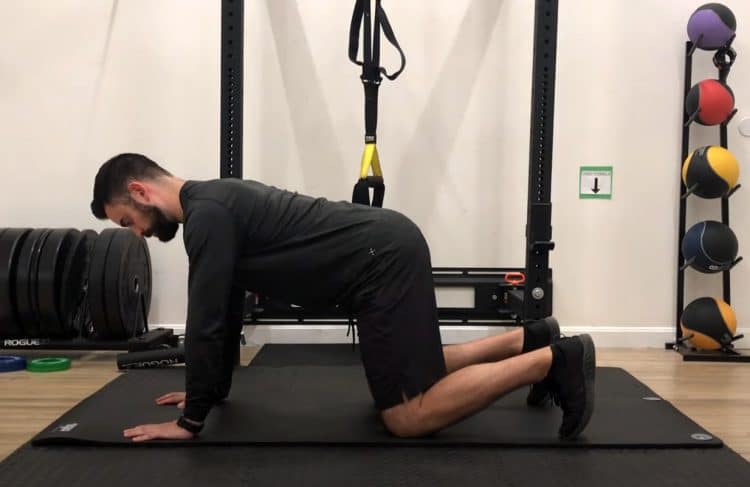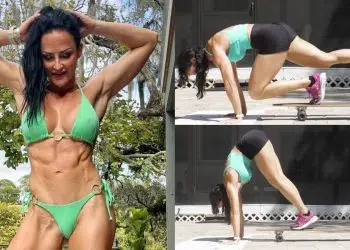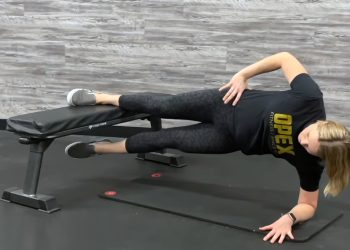We’re all familiar and then some with the plank exercise. With the recent resurgence of the traditional plank many variations have emerged. From side planks to dynamic planks, the bear plank is a bit of an outlier.
Whether your goal is to improve stability, get a six pack, or increase performance in a myriad of lifts and athletic endeavors, the bear plank just might be what you need.
Let’s look at what the bear plank is, how to do it, and how we can program it into our training. Plus, we’ll list a few variations to keep things interesting.
What Does The Bear Plank Work?
As with many plank variations the bear plank will stress the core, however, it will take the stress off of the lower back for many while working the core to a greater degree.
Rectus Abdominis
This familiar muscle comprises the wall that makes up the coveted six pack – or eight pack since it has eight heads of muscles. It functions to stabilize the spine and allow concentric and eccentric action forward and back flexion of the trunk of the body.
The bear plank acts to isometrically isolate the rectus abdominis by increasing the need for stabilizing the entire upper body and keeping the ribcage and pelvis in line.
Level Up Your Fitness: Join our 💪 strong community in Fitness Volt Newsletter. Get daily inspiration, expert-backed workouts, nutrition tips, the latest in strength sports, and the support you need to reach your goals. Subscribe for free!
Internal and External Obliques
These muscles line the sides of your torso allowing side bending and rotation. The internal and external obliques aid in stabilizing the torso during many exercises, especially standing presses, squats, and deadlifts.
Bear planks will stress the obliques specifically if certain variations are used such as the single-legged version.
Lumbar
As an integral part of the core, the lower back area is used to help stabilize your trunk and provide a strong foundation during many lifts. The bear plank can help strengthen this area and provide a good base for lifts that require a solid midsection such as squats.
Other Areas Affected
Since the bear plank utilizes so many muscles, there are others that act as secondary stabilizers. Areas such as the deltoids, traps, triceps, pecs, lats, and quads all become activated. This creates a whole body, synergistic effect that trains the body to work more cohesively.
What are The Benefits of The Bear Plank?
Other than the common knowledge benefits such as another way to stimulate your abs, the bear plank may surprise you in some of its more nuanced advantages.

Core Activation
Many traditional abdominal exercises use dynamic motion in order to stimulate activation. The bear plank causes you to isometrically contract all the muscle groups listed above. This creates a stronger core enabling more control.
Performance
With more stabilization comes more of an ability to create force. This force can aid in many things performance-based such as running and jumping which coincides well with cross-training style programs.
Posture
Since the core supports the spine and strengthens the abdominal area specifically, your posture will improve as a result. With this newfound improved posture comes less back pain, less shoulder and neck aches, and a stronger spine.
How to Do the Bear Plank?
So what makes the bear plank so different from the traditional version? Let’s look at how to execute the bear plank correctly.
- Much like the traditional plank, set your hands on the floor extended below your shoulders and your back and spine in a straight line. Stabilize your shoulders by bringing them down toward your waist.
- Bend your knees 90 degrees and your hips 90 degrees so you are in the classic hands and knees position.
- Shift your weight more toward your shoulders, tighten your abdominals, glutes, and quads to maintain the straight spine position. This will create a stable base.
- While keeping that stable base, lift your knees off the floor an inch or two. Your abdominals, quads, and shoulders should all feel tension in the top position. Hold this position.
Should you do The Bear Plank?
If you’re reading this then you more than likely fit into a certain category of lifter. Whether you consider yourself a bodybuilder, weightlifter, or athlete you can benefit from the bear plank.
Bodybuilders
As a bodybuilder you may focus almost exclusively on building muscle, but a strong midsection is vital to overall physique development. As stated earlier, planks increase core stabilization. This will potentially assist in other important muscle-building lifts.
Weightlifters
The traditional weightlifter performs extremely dynamic exercises such as snatches, jerks and clean and presses so planks can also aid in stabilizing these lifts as well. It can also act as an excellent warm up for your core prior to the main lifts scheduled for that day.
Level Up Your Fitness: Join our 💪 strong community in Fitness Volt Newsletter. Get daily inspiration, expert-backed workouts, nutrition tips, the latest in strength sports, and the support you need to reach your goals. Subscribe for free!
Athletes
Since the bear plank increases force in the core, athletes can benefit from including this exercise in their program. Additionally, because many more muscles are involved regarding the shoulder area and legs, more whole-body awareness and stability can be achieved for dynamic athletic moves.
How do you Program The Bear Plank?
As with any exercise, programming needs to be deliberate and progressive. With the bear plank building size isn’t the goal. Endurance and strength are the two main objectives.
Beginners should start with three times per week of frequency and around three rounds each workout. Hold each plank for 20 to 30 seconds with a short rest between sets. You can start your workout with planks, for a good warm up, or after along with the rest of your abdominal training.
After you’re comfortable with the above workout and are performing good form, increase the duration and frequency. After two to three weeks, increase to four or five sets of 30 to 60 seconds each. You can also reduce rest between sets as your strength improves.
Over time you’ll find that it’s unrealistic to increase frequency and volume for practical reasons. That’s where variations can come in.
Bear Plank Variations
There are plenty of ways to make the bear plank more challenging. All it requires is some proper execution, a willingness to be challenged, and a simple weight plate of your choice. You also don’t need any special equipment to get more out of your core training.
Weighted Bear Plank
Using a weight plate or another weighted device (a weighted vest will do nicely), have your training partner place the weight on the upper portion of your back in a stable position so it won’t slide. Perform the bear plank as usual.
You may need to decrease your time in the plank position to compensate for the added resistance. Once you perfect the weighted version, you can either increase the weight or increase time and/or number of sets.
Bear Plank to Plank
For this variation start in the bear plank position and perform as usual. Once your time has been achieved, reposition your legs into the traditional plank position without resting or releasing tension. The traditional plank will have you extend your legs out behind you into a straight position.
Hold this for a count of 20 to 30 seconds and then rest. After some experience and progress, try alternating between the two positions for several rounds as an added challenge.
Bear Crawl
Bear Crawls are a great bodyweight conditioning and core exercise. Bear Crawl is very similar to a baby crawl but requires you to bear the weight on your hands and toes rather than your knees. Excellent exercise in core control and focused breathing.
Single Leg Lift
Here you’ll be borrowing a chapter out of the traditional plank book of variations. Position yourself in the normal bear plank position. Once you’re there for a count, raise one foot off the floor a few inches. You will have to slightly adjust where you distribute your weight, but that’s what this new challenge is all about as you’ll be activating your obliques a bit more.
Once you’re in that new position for a count, switch sides and do the same for the opposing foot. Once you’ve switched sides for a count, take a short rest.
Bird Dog
The bird dog sure doesn’t sound like the typical exercise but make no mistake, it’s actually an effective and commonly used movement for developing stability, strengthening the core, glutes, improving shoulder mobility, and more.
Hands to Elbow
Finally, another variation that poses a unique challenge is the hands to elbow. This is yet another exercise similar to the traditional plank in that you’ll be starting in the normal bear plank position. Next, you will drop each arm so that you’ll then be supported by your elbow. Drop one side then the other.
Next, raise back up to your hand position one side at a time to bring you back to the normal bear plank. Keep alternating from hands to elbows supported slowly and deliberately for a timed set. Afterward, rest a short duration and repeat for several sets.
In Closing
No matter the goal, adding bear planks to your training will spice up any core routine. Whether your intent is to chisel more detail in your abs, support other exercises with more stability, or improve athletic performance, the bear plank is a welcomed addition to any program for a new and interesting challenge.
Interested in measuring your progress? Check out our strength standards for Hip Abduction, Clean and Press, Clean, and more.











